 By Staff By Staff
February 21st, 2024
BURLINGTON, ON
The Region of Halton now has a new Commissioner of Health and Medical Officer of Health.
Dr. Deepika Lobo as served as an Associate Medical Officer of Health since joining Halton Region in 2019 and has been Acting Commissioner of Health since September 2023.
The job is one of the most critical in the community ; managing the pandemic was a task that, at the time, proved to be a challenge that took every skill then Medical Officer of Health Dr. Hamidah Meghani had to keep the public informed and to put in place the data collection procedures that were necessary. She was newly appointed at the time and faced a situation that shut down the world for a period of time while a full understanding of what COVID19 was and how to deal with it.
Jobs like that burn people out.
Dr. Lobo’s experience, knowledge, and leadership capabilities will keep our public health services strong and keep our residents healthy.”
 Dr. Deepika Lobo: Commissioner of Health and Medical Officer of Health. Dr. Lobo completed her residency in Public Health & Preventive Medicine through the DeGroote School of Medicine at McMaster University and is a Fellow with the Royal College of Physicians and Surgeons of Canada. Dr. Lobo obtained her Doctor of Medicine from Kasturba Medical College at Manipal University in India, and has the degrees of Master of Public Health and Master of Business Administration from McMaster University.
The Halton Region Health Department provides a range of accessible and effective Public Health and Paramedic Services programs. Public Health programs support the physical and mental health and well-being of residents that aim to reduce health inequities, protect and promote health, and prevent injury and disease. Paramedic Services provide advanced 24/7 pre-hospital emergency care and community paramedic programs and deliver public awareness programs, including CPR, public access defibrillation, and injury prevention.

 By Pepper Parr By Pepper Parr
February 21st, 2024
BURLINGTON, ON
 The property to the right of Cooke Blvd is where there are thousands of housing units. At the top left there is a proposed storm water holding area. While not clear just where park space should be they are at least indicating there should be some park space. With some creative thinking a park could be build atop of the storm water pond. It has been done elsewhere before. A public meeting has been scheduled for March 4, 2024 on an ADI Developmen Group in the Aldershot community on Masonry Road
The meeting is a Statutory meeting required under the Planning Act.
It is an occasion when the public can put question to Staff and the developer if they choose to participate.
The is an event that needs as much participation from the public is as possible – why? We will get to that in a bit.
Proposed Development
The applications propose to amend the Official Plan and Zoning By-law to permit a mixed-use development comprising three tall buildings with retail uses at ground level and residential uses above.
In the original proposal (2022): Building A (northwest corner of site) was 36 storeys tall including a 4-storey podium. Building B (southeast) was 26 storeys tall. Building C (southwest) was 36 storeys tall. Buildings B and C shared a three-storey podium. The proposed buildings contained a total of 1,139 residential units and 231m2 of ground-level retail at the corner of Masonry Court and Cooke Blvd. 1,031 parking spaces were proposed within five levels of underground parking.
 A rendering of the additional three towers ADI wants to add to an already big development – you will have to look really hard to see where park space will be located. In the revised proposal (2023): Building A (northwest) is 33 storeys tall including a 12-storey podium. Building B (southeast) is 29 storeys including a six-storey podium that steps down to three storeys on the north side. Building C (southwest) is 31 storeys including a six-storey podium. The buildings are no longer connected to each other, and a plaza has been introduced at the ground level between Buildings B and C. The total number of residential units has increased from 1,139 to 1,165. The total amount of retail floor area has increased from 231m2 to 495m2. The total number of parking spaces has increased from 1,031 to 1,145 spaces within 6 underground parking levels.
The developer provided renderings that make the three tower development look very inviting. There was a point when much of the space was to be park space – that idea didn’t get the push it needed from the ward Councillor.
The Statutory meeting taking place March 4th is a public event and you can participate virtually and delegate to City Council. Delegating is tricky – if you need some help – pop us a note at publisher@bgzt.ca and we will take you through the steps.
 It does look inviting – but where is the park space for the 2000 families in the community. The community that ADI built is much more than the three towers they want to add. Set out below are some of the buildings. There is much in the way of community space and there doesn’t appear to be much in the way of small community organizations. The ADI people invest in building – they don’t invest in creating community nor does the ward Councillor.
 This is the eastern boundary of the Station West development that is walking distance to the GO station.  It was a big bold development set on property bought by xxx from Paletta who will tell you now that selling the property was not one of the best decisions.  This is one portion of what it a very large development that needed a small supermarket and some park space.  Another part of a very big development that has few social amenities. The Bateman Community Centre is going to provide all kinds of space for the public. The ADI development is a stiff walk to LaSalle Park 
 By Pepper Parr By Pepper Parr
February 21st, 2024
BURLINGTON, ON
Part two of a three part series on Bateman engagement taking place
 Denise Beard: Manager of Community Development. During her lengthy outline of what had been done in terms of engagement Denise Beard, Manager Manager of Community Development made mention of a pilot program that would take place at Tansley Woods. “We want to investigate this notion of community coming together a little more. The idea of using the open community space at Tansley where people could come together really resonated with us.
“There is some space up there within the community center to really open and turn it into a space where people can connect and socialize – using the rooms that might be available if nothing’s programmed. Can we open them up to allow community to use those spaces?
The notion of social anchor, a phrase coined by Beard and her team, was something she said the community really took to – they were both loud and clear about having places where people can connect and socialize. Can we open them up to allow community to use those spaces and see what happens?
Maybe a communal kitchen where people could bring their food and then eat together and break bread together as it were.
 There is space at Tansley Wood that isn’t being used all that much – could be a pilot site for Bateman program development. “We’re looking to try to do things like that at Tansley to assess over the next couple of years what that might look like at Robert Bateman..The objective is to help guide us in the design of that space moving forward.
We’ll be striving to see just what a social anchor pilot at Tansley Woods would look like. The people we spoke to were intrigued and our team is eager to see how that takes off and hopefully we can learn how to meet the community demand we expect to see in the in the future at Bateman.
The second thing that I wanted to ask about is more of a question. It’s just been so much conversation, not so much thank goodness this winter because it’s been a little bit warmer and we haven’t had too many critically cold nights. But the idea of a warming center or possibility of overnight shelter on cold nights has that been built in at all to this idea of the pilot social anchor at Tansley and or potentially Bateman down the road.
 There are three large rooms that would serve as pilot sites. An opportunity for people to use the showers at Tansley if people had to stay overnight.
Mayor Meed Ward thought it was a brilliant idea and Council seemed to go along with it.
Beard now has a bit of a runway she can use to get back to some of the people she talked with and take the idea a little further.
Interesting approach – let’s see where they take it.
Related news story:
Engagement on Bateman programs is taking place.

 By Staff By Staff
February 21, 2024
BURLINGTON, ON
Metrolinx wants you to remember the One Fare Program that will launch next Monday, February 26, 2024!
The province – in collaboration with Metrolinx and local transit agencies – is working to connect communities across the region. Through Ontario’s One Fare Program, transferring from one transit system to another will be simpler, more convenient and more affordable.
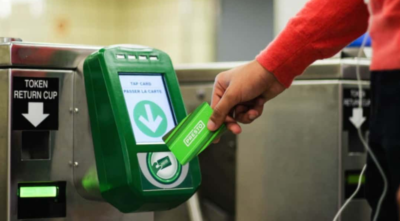 It is just that simple. Ontario’s One Fare Program allows transit users to only pay once when travelling between the TTC, GO Transit and participating transit systems like Brampton Transit, Durham Region Transit, MiWay and York Region Transit.
When travelling between systems, the discount will be applied automatically when you tap a PRESTO card, credit or debit, or PRESTO in Google Wallet to connect between GO Transit, TTC and all participating transit systems.
What you need to know:
- Free transfers: For trips between the TTC and GO Transit, your TTC fare is free, regardless of travel direction and the cost of your TTC trip is discounted from your overall trip cost. For trips between the TTC and other local transit systems, the second fare of your trip is free.
- Transfer flexibility: Transfers are valid for two hours when trips start on local transit and three hours when you tap on a GO bus or train.
- Proof of payment: The payment method you use to tap is your proof of payment. Customers paying with PRESTO in Google Wallet, credit or debit card, must tap on and off with the same card.
 One far will get you into Toronto and almost wherever you want to go in that City. For an adult who commutes five days a week, the One Fare Program could save them up to$1,600 per year.
You can learn more about Ontario’s One Fare Program here and watch a step by step video on our YouTube channel.

 Pepper Parr Pepper Parr
February 20th, 2024
BURLINGTON, ON
These were questions that I had in mind when I began to write this article on the comments Denise Beard made when she addressed Council recently.
Engagement is a skill that requires innovation, patience and a skill set backed up by experience.
That said – why has the City had so much difficulty?
Was it the size of the project?
Was it a hangover from the loss of the Bateman High School?
Something made everyone react differently.
Did we know how to do Community Engagement for a project this size?
During the discussion with Council ward 2 Councillor said “we are not there yet” and wanted to defer any motions. That was the last thing the public wanted.
 Denise Beard, Senior Manager of Community Development. Denise Beard, Senior Manager of Community Development sharing the feedback she heard during her extensive community engagement on the Robert Bateman. Community Center Project told Council recently that “The community engagement was the result of hours of staff time working collaboratively.”
Beard was sharing “things we heard from the community on the visioning and on what we heard from the not for profit sector and the business sector about their visions.
“We approached groups through requests for expressions of interest. We wanted to identify if there’s any business areas or themes that committee would not like to see moving forward within the community center and have a discussion around those.
Staff are readying for the next steps around the engagement process; we wanted you to be aware of a concept that came out really loud and clear.
“A need for arts and culture space; that was a very strong theme both for creating, performing – having exhibits. The local community is really coming forward and saying we don’t have a place where we feel that we can create and showcase just minor community driven arts and culture initiatives – that kept coming up over and over during the engagement sessions.
“We held three in person sessions, where we ran through an “innovation in a box” exercises with the community. We also ran one virtual session. We had staff at booths at both at Food for Feedback and at the Appleby Line Street Festival to get more input from the community in a brainstorming opportunity for people during the festivals.
 Denise Beard giving it everything she has – was showing a media presentation some of the programs offered by the parks people. “We were generated 70 unique ideas; lots of interest from the community on the space and what they’d like to see in there. We heard expressions of interest from the arts and culture from specific not for profits wanting to have exclusive space for their creative and performing spaces.
“We had people come forward offering day cares both for preschoolers, elders and respite care with some sort of social programming to help offset daycare needs.
“Food was a major component that was seen as key with the community space;, that there’s a place that brings people together both socially and from a sharing of cultures, where people really can sit down converse and really link with each other over food.
“Mention was made of a Creative Kitchen that could be a social enterprise where people could create foods for sale and do some training programs where people could learn the hospitality trades and then offer that service within the Community Center.
“There’s lots of interest and comments about the gyms and the especially around pickle ball. Also lots of engagement around the former shops, whether that’s a Repair Cafe, woodworking classes and skills training.
“We heard lots of feedback around a link between science and technology and creative spaces and interest in some great opportunity for social programming and services.
“In our discussions something we’re calling social anchor began to become clear. People really felt like they wanted this common social space. It was a very interesting conversation with community when we were in the engagement sessions because initially we would start in conversation. Inevitably somebody said they wanted additional senior space at Bateman and then somebody else saying I would like to use Bateman where conversations not led by staff, but within the groups themselves.
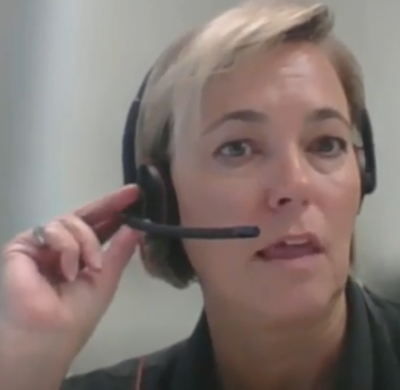 People really felt like they wanted this common social space. Discussion came to this notion “we want to community centered not segregated by age or demographic, but a place where we can all come together and learn from each other and share with each other. They really wanted a place that was welcoming, open and free for them to integrate and just ad hoc come together and enjoy each other’s company.
At this point Beard closed her remarks with there is more engagement to be done but at this point we need to hear from you. Before she did that she spoke for a few minutes about a pilot project Staff wanted to run at Tansley Woods where there is space that isn’t used all that month. The pilot project is part two of this three part series

 By Staff By Staff
February 20th, 2024
BURLINGTON, ON
Marit Stiles, Leader of the Official Opposition NDP, returned to Question Period after the legislative break focused on holding Ford’s Conservatives accountable for Bill 124, Ontario’s strained healthcare system, worsening housing crisis, and skyrocketing cost-of-living:
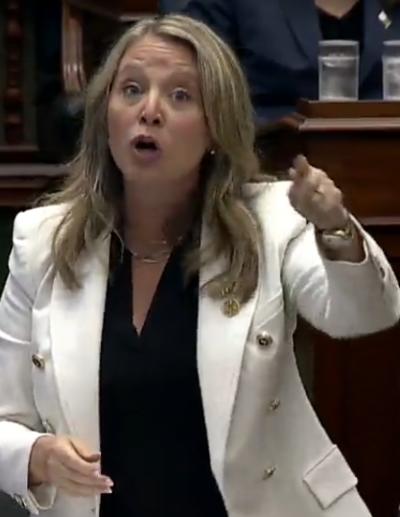 NDP :leader of the Opposition letting the Premier know what is on her mind. “We start this new session with yet another policy reversal – Bill 124, a Bill that is and always was unconstitutional,” said Stiles.
“Will the Premier apologize to these workers for stealing their wages with Bill 124 and finally tell Ontarians how much money they spent fighting hardworking nurses, PSWs, teachers, educational assistants and all public sector workers in court?”
Stiles and the NDP refused to allow Conservatives to distract from their track record of corrupt policies, continuous backtracking and lack of real solutions.
“Our province was already struggling with rampant hallway medicine when this government came in, and their choice to target workers made things even worse. Will he admit his choices worsened the crisis facing our health care system?”
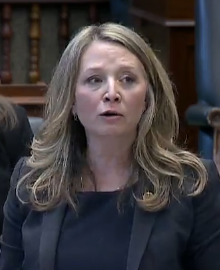 Marit Stiles called on Ford’s Conservatives to focus their next reversal on fixing the mess they caused. Laser-focused on reversing the damage Ford’s Conservatives have done to the province’s healthcare system, Stiles called on Ford’s Conservatives to focus their next reversal on fixing the mess they caused.
“If the government is going to continue backing up the policy train this session, can they make reversing their privatization of health care the next signature policy reversal?”
 Bonnie Crombie, Leader of the few Liberals in the Legislature: It’s only a matter of time Doug; only a matter of time. It isn’t going to get any easier for Premier Ford going forward. The NDP are the only people hammering the Premier and that is likely to be the case until Bonnie Crombie gets a seat in the Legislature.
The Milton seat will become available in about 45 days when the Premier has to call a by-election. Ford does not want Bonnie Crombie buzzing about his ears – expect the by-election call to be is as far ahead is as possible.

 By Staff By Staff
February 20th, 2024
BURLINGTON, ON
Festivals and events in Burlington are a source of civic pride, social connections, an arts and culture platform and can be an economic boost.
 The Santa Claus parade, Sound of Music and Ribfest are big deal and big draw events. The Festivals people have yet to find a way to sponsor smaller events north of the QEW. The City is looking for public input in developing a Festivals and Events Policy to help ensure the best services and experiences for all,
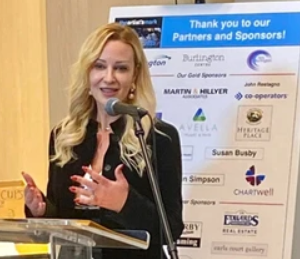 Angela Paparizo, Manager of Arts and Culture. Residents are invited to complete an online survey at getinvolvedburlington.ca/eventspolicy to share feedback on their satisfaction with events on City property and their wishes for future direction.
The purpose of the proposed policy is to provide a set of guidelines and criteria to assist with planning and managing events on City of Burlington property.
The survey is open now until March 5. Responses will be used to guide the discussion of criteria and components of a policy at the Committee of the Whole and City Council in April.
Angela Paparizo, Manager of Arts and Culture said “This policy will help us move towards our strategic goal of providing the best services and experiences for all. We want to find the balance between providing festivals and events of great value while ensuring we have the right locations, mix of events and timing.”
Links and Resources
getinvolvedburlington.ca/eventspolicy

 By Pepper Parr By Pepper Parr
February 20th, 2024
BURLINGTON, ON
And so we now know who the next City Manager is going to be.
City Council chose someone local, a man who knows the community well and who has performed very well as the President and CAO of Conservation Halton.
The comments made by his peers have been the kind of thing a politician would love.
 Hassaan Basit reports to City Hall April 22nd; a cultural change comes with him. However, make no mistake about Haassan Basit – he is not a politician – he is a very focused administrator who reshaped what Conservation Halton was into an organization that has shown it knows how to listen.
Metamorphoses, his initiative to reshape the Conservation Halton (CH) relationship with the public was one of the first occasions when the public got to see what Basit’s approach would be when he as appointed President and CAO of CH.
Basit could see the changes that were coming in the demand for places to go and appreciate the outdoors. While Spencer Smith Park is a focal point for Burlington it is close to capacity. He began to figure out how Conservation Halton would accommodate the thousands of people who will want to visit the CH properties. He knew his costs were going to increase. Instead of just announcing price increases he went to the community and asked what they thought the price increase should amount to and in doing so had the people who use the CH properties buy into an increase rather than see it imposed.
There are a few things that Basit will begin thinking about from a municipal perspective rather than regional when he gets to City Hall.
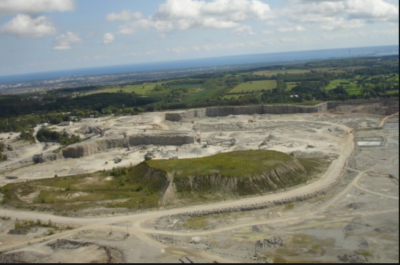 The Nelson Quarry is both a problem and a significant opportunity. What is going to happen to the Nelson Quarry site? It was never a major CH challenge other than it was basically across the road from Mt Nemo. Municipally it is a major issue politically. Basit is going to have to find a way to help the current council see what the bigger picture could be.
He also has to adapt to a new form of relationship. At CH he was the President and Chief Administrative Officer. His job was to do the long term thinking and then to carry out the conclusions he had arrived at once they had been approved at the Board level.
As City Manager, the policy part rests in the hands of city council. A City Manager certainly informs that policy and creates a civic administration that can deliver services based on the policy.
Conservation Halton was close to a sleepy organization that wasn’t known for much in the way of innovation. Basit learned during the 2014 floods just how unprepared CH was for the kind of Climate Change the city was going to have to adapt to. At the time, 2014, there was a single source of data for CH to rely upon in terms of knowing what was taking place – and that source had problems getting data from the source to the people who needed the data.
 The 2014 flood ripped through several of the creeks resulting in huge damage. Today there is a sophisticated network that collects data and feeds in into CH, an organization that now has duty officers in place 24/7.
The public began to see some very well informed people representing CH at different levels of the City and the Region.
How many of those people will Basit want to bring with him?
Haassan Basit is a listener. He will have all kinds of ideas and initiatives he will want to get started on – but he will first listen to the Executive Director level team that is in place and focus on building the trust needed to mould a team that can take on the challenges the city faces.
He is blessed with some exceptionally committed and accomplished people within City Hall. Chad MacDonald and Sheila Jones should fit in very well with the team he will create. There are others.
One of the biggest challenges will be upgrading the culture that prevails at City Hall – it is not a particularly happy ship; – the staff turnover is too high. Some regrettable hires were made; people who showed great promise realized that the professional growth they saw for themselves were not going to be met in Burlington and moved on.
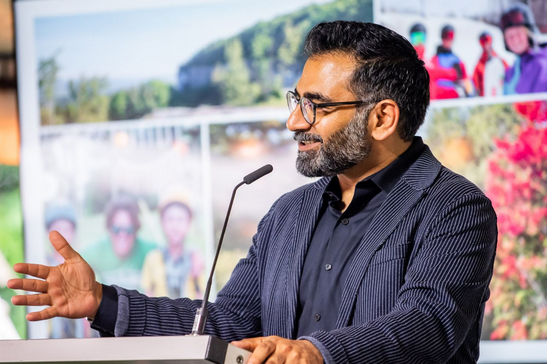 Haassan Basit addressing Conservation Authority staff In the past five years there have been a number of reports taken to council on the scope of the problem, including the identification of far too many silos within the organization.
Basit is very well connected at the provincial level. On more than one occasion he has met with Premier Ford who asked for advice that we are told was followed.
His relationship with the Minister that oversees Conservation Authorities is solid and he has played a large part in the re-shaping of Ontario Conservation Authority.
Some thought Basit would be invited to Queen’s Park as an Assistant Deputy Minister and move on to being a Deputy Minister.
That could happen yet – but please, not before Hassaan has done what needs to be done in Burlington.

 By Staff By Staff
February 19th, 2024
BURLINGTON, ON
his event is a poverty awareness event, where fundraising is done to help support the 106 programs that United Way Halton & Hamilton supports. Many people who are experiencing poverty will need to access multiple social services supports, as poverty is a complex issue.
 When housing is unaffordable and people need the car they have to get to work – the car becomes “home” It is not a solution. The event is called Sleepless in our Cities.
EVENT OBJECTIVE
A significant number of our community members are confronted daily with challenging financial decisions, such as choosing between covering heating costs or providing food for their families. When individuals are struggling and faced with the pressures of financial instability, choices like these can seem unbearable. Many feel shame and are discouraged from seeking help, due to the stigma around poverty.
 Sleepless In Our Cities aims to bring awareness about the daily challenges faced by youth and adults living in poverty. Event participants are asked to sleep in their cars in the middle of winter as an act and gesture, as well as to raise funds to help our neighbours who need our support. By participating in this event, you are connecting with the community and showing a willingness to have open conversations about the impacts of local poverty. Sleepless In Our Cities aims to bring awareness about the daily challenges faced by youth and adults living in poverty. Event participants are asked to sleep in their cars in the middle of winter as an act and gesture, as well as to raise funds to help our neighbours who need our support. By participating in this event, you are connecting with the community and showing a willingness to have open conversations about the impacts of local poverty.
Event Details
When: February 23, 2024 | 10 PM – 8 AM
 There are too many small tent communities that have become home for some people. Resources have to be found to properly house people. What: Sleepless in Our Cities is a fundraising event that aims to raise awareness around the issue of poverty in our local communities, by asking participants to sleep in their cars overnight as they raise money for our friends and neighbours who need our support.
Event participants will sleep overnight in their cars on Friday, February 23 from 10 PM to 8 AM the following day. This form of participation is an act and gesture intended to raise awareness of poverty in our local communities
People can get more information here on our website at: https://www.uwhh.ca/event/sleepless-in-our-cities/
Related news story:
Not quite there yet in the 2024 United Way Drive

 By Staff By Staff
February 19th, 2024
BURLINGTON, ON
The people of Ukraine have taken the painting of Easter eggs to levels that are beautiful to look at.
Celebrate the Ukrainian contribution to Easter egg dyeing
 A cultural art form. The Easter egg dyeing practised by the Ukrainian community is called Pysanky. If you can draw lines and circles, you can make these beautiful eggs. No two eggs will ever be the same but will be your work of art.
A workshop is being given on Saturday, February 24th at the Ukrainian Banquet Hall on Pine Street.
Demo and instructions are provided by local Ukrainian egg decorating authority, If you can draw lines and circles, you can make these beautiful eggs. No two eggs will ever be the same but will be your work of art.

Register by email to:
natalienebesny@gmail.com
Space is limited.

 By Catalin Constantin By Catalin Constantin
February 19th, 2024
BURLINGTON, ON
Big data analytics is business’s closest ally and remains transformative in industries that make the most use of it.
 Loads of data out there – finding what you need and putting those information nuggets to work for you is now possible. It enables organizations to digest a lot of data in tiny pieces. It enables them to comprehend some attributes like what their clients are doing, their trends and how they interact with the enterprise.
Certainly, there are many advantages which may be received by an online casino if they can use big data for their benefit.
Personalized Services
Online casinos have used the technology to ensure they offer a level of rationalization as they look to keep players onboard due to the competitive nature of the sector. Although it is hard to pinpoint the actual number of options players have, there are thought to be thousands of sites all offering gambling activities, thus highlighting why there has been a focus on making things as personal as possible.
They can create unique experiences that are tailored to the player, as they can analyze their behaviours and playing patterns. For instance, they can create recommendations based on their location and the time they spend on the website, or even give them ways in which they can personalize their profile more, such as providing them with aesthetic features.
A customized selection of games can be offered
 While there are thousands of game – the choices are overwhelming at time – the objective for the player is to have fun – and winning helps. Although an online casino might have thousands of games available to pick and play from, they can use big data to make sure only the most relevant options are more visible to the player. Big data allows them to see which games are being enjoyed the most, which they can then ensure they continue to show on each visit.
By making the game library look more appealing because it is based on personal preferences, the casino will immediately become more appealing than other competitors that may not have any information or data about the visitor. This can help retain them and give them the competitive advantage that is so desperately needed in this saturated industry.
Personalized rewards and bonuses can be used
The online casino can also use big data analytics to allow its players to enjoy tailored bonuses and rewards. They can use the collected data to make personalized offers that they know will have a greater chance of being redeemed, thus allowing them to be more efficient and potentially increase their revenues.
An example of this might be offering a player a free spins bonus on a slot game that they have been enjoying. In doing so, a player might be more likely to use the bonus as it aligns with their interests and playing preferences. If they were offered a bonus on a game they have never shown an interest in, then it is likely they would avoid it.
Improve player and casino safety
Responsible gambling and safety have been huge areas of the online casino industry in recent years, with there having been a focus on these aspects externally. However, the use of big data analytics has allowed operators to do so much more than they were once able to, thus helping them promote a more positive experience.
 Use the data to make sure players are better protected from potential threats to player and casino safety. Big data has allowed the casino to track player trends and behaviours related to their gambling activities and their spending. They are better positioned to spot when a player may be in trouble, meaning they can act before it is too late. Additionally, they can use the data to make sure they are also better protected from potential threats to player and casino safety. They can use the data to prevent fraudulent activities, which can help to foster a sense of trust among its player base.
Big data’s highly influential impact on the online casino industry
As there are so many more aspects and elements in which big data analysis has had a positive impact in personalizing the online casino experience for players, it is clear that it is impossible to deny how crucial it has become for the industry.
With so many different options now available in the market for players to choose from, a level of personalization is needed nowadays to convince visitors that they truly value their custom. In doing this, they are better positioned to retain them and not lose them to a competitor.

 By Pepper Parr By Pepper Parr
February 18th, 2024
BURLINGTON, ON
The City spends millions on transit.
Tens of thousands don’t use the service.
Council buys the Staff argument that transit is essential going forward.
Tough place to be.
Counsellor Paul Sharman will talk about our getting to the point where we won’t own cars but will rely on a service where you will dial up a company that will have a car at our front door that takes you to exactly where we want to go – with no one actually driving that car.
That isn’t going to happen in my lifetime nor that of Paul Sharmans.
Then where are we going to go with transit?
Two recent services done recently; one by Get Involved, a part of the city web site and Deloitte, an accounting firm hired by the city to survey public opinion on levels of satisfaction on services delivered.
What is interesting is that they ask if people use transit and if they don’t – why?
No one seems to be asking people – what do you expect to use to get around town or when you want to visit with friends in Hamilton, Guelph or Kingston. And where does the GO service fit into the thinking people do about how they are going to get around?
Let’s look at the data we do have.
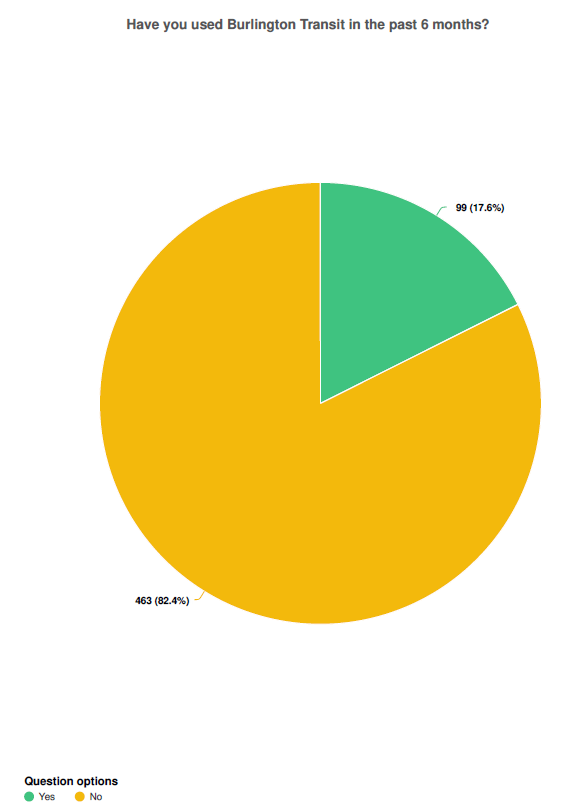
No direct routes, takes too long to get where you want to go and not convenient are the leading reasons given for not using transit. Are there solutions that could attract people to using transit? Probably not in the near future.
There is no data that compares the Burlington experience with other Regions; York has made great strides and Brampton had the benefit of a very innovative transit executive that Burlington hired. She decided to retire before the job was done.
The survey work done by Deloitte had questions on transit. Their data was basically the same as the data collected by Get Involved.
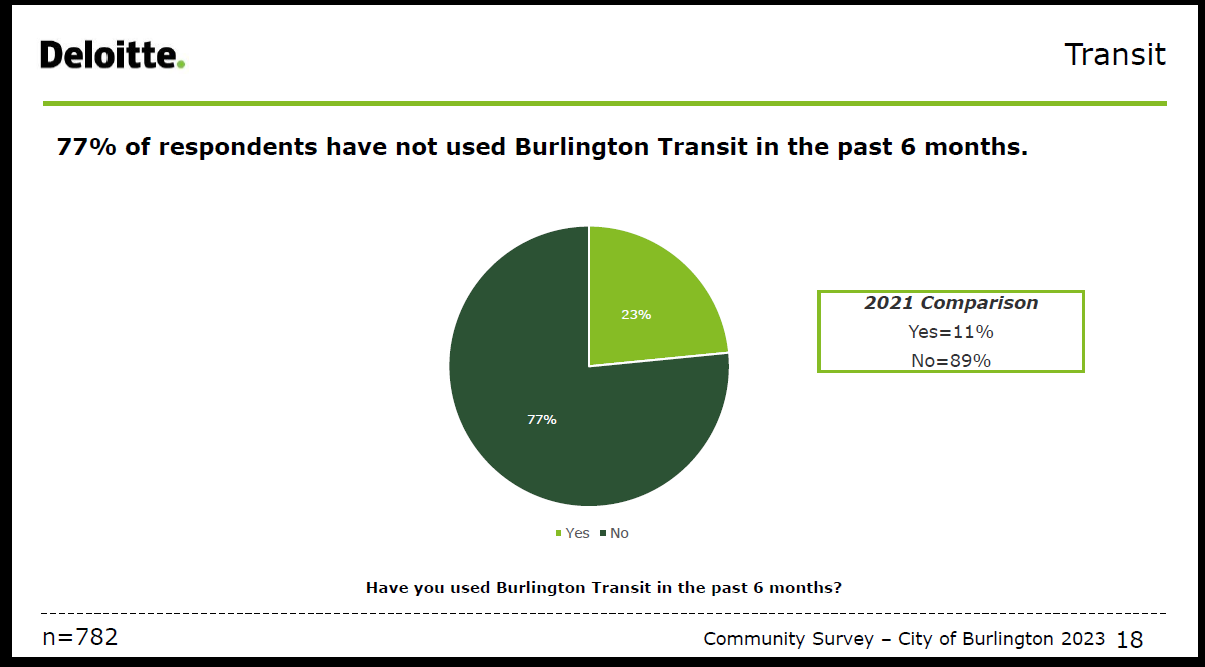
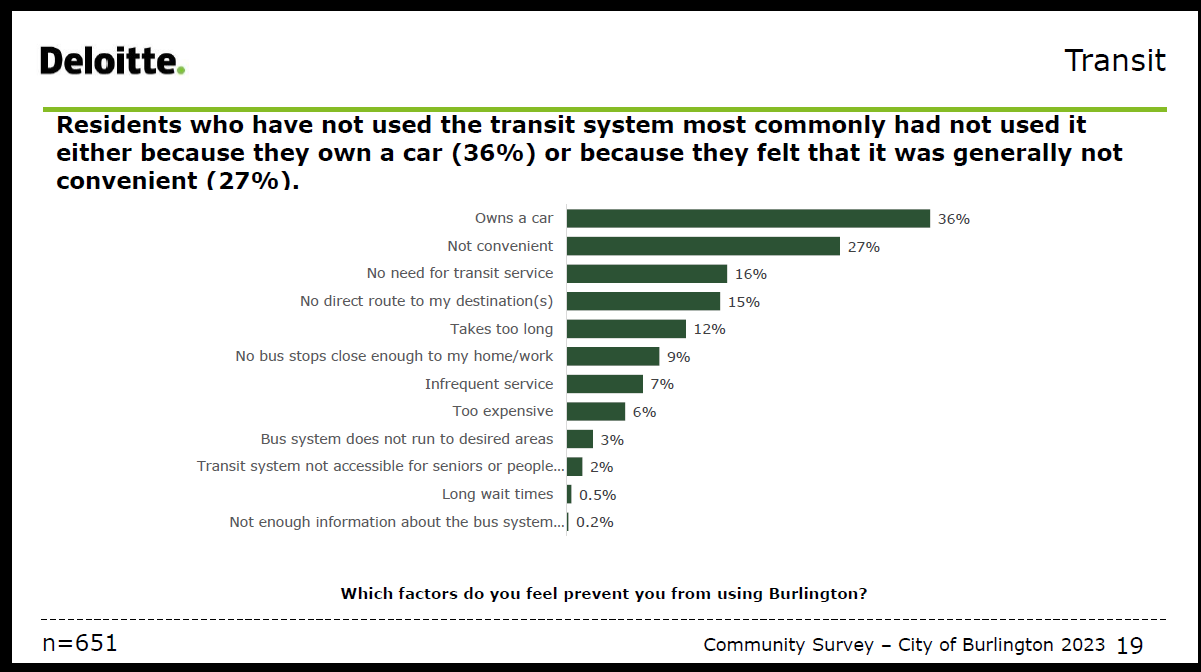
What is the take away on this?
Council is committed to transit; there was a time, before Covid, when the ridership numbers were growing significantly.
What the public is not seeing are small pilot initiatives developed by Burlington Transit testing some of the options that are being used elsewhere.
One gets the sense that Council has settled into a model that provides transit for those who do not have a car. Those with cars will drive and complain regularly about grid lock without coming to terms with the fact that no new road capacity is going to be built.
At some point some innovative thinking is going to have to be applied.
Related news stories:
Wishful thinking going back to 2019
The 5 year Transit Strategic Plan took us to 2023. Needs an update – badly

 By Staff By Staff
February 17th, 2023
Burlington, ON
Several years ago Andrea Battista formed a chamber music group and called it: Effusion.
 It started when she was awarded a grant from the Burlington Arts and Culture Fund to put on a concert, The Gratitude Project, just as things opened up after the pandemic. It was extremely well received by the public. It started when she was awarded a grant from the Burlington Arts and Culture Fund to put on a concert, The Gratitude Project, just as things opened up after the pandemic. It was extremely well received by the public.
This second, concert features the work of 18 different female composers. Some are classical, some composed for musical theatre and some wrote works for television and film amounting to short selections from many different styles of music.
Local musicians, eight of them, are part of Effusion – Sunday, March 3rd at St. Christopher’s Anglican Church, Guelph Line, 3:30 pm
REMEMBER THE LADIES COMPOSER AND REPERTOIRE LIST
SATURDAY, MARCH 3, 2024
Delores Claman Hockey Night in Canada theme, instrumental
Alexandra Harwood All Creatures Great and Small theme, instrumental
Fanny Mendelssohn Gondellied, voice and piano
Marianne von Martinez Sonata in E major, strings
Wanda Landowska Berceuse, instrumental
Buffy Ste Marie Until It’s Time for You to Go, voice and guitar
Mel Bonis Fughetta from Suite dans le style ancien, instrumental
Joni Mitchell River, voice, piano and guitar
Keiko Fujiie Three Pieces for Clarinet, No.1, clarinet
Lucy Simon Lily’s Eyes, from The Secret Garden, voice, instruments
Intermission
Amy Beach Waltz, instrumental
Cecile Chaminade Fleur Jetee, voice and piano
Serenade aux Etoiles, flute and piano
Carole King You’ve Got a Friend, voice and piano
Natalie Younglai Reunion, instrumental
Rebecca Clarke Prelude, viola and clarinet
Lisa Lambert I am Aldolpho, The Drowsy Chaperone, voice and piano
Florence Price Nimble Feet, piano
Consuelo Gonzalez Besame Mucho, voice, piano and guitar
Laura Nyro And When I Die, the ensemble


 By Pepper Parr By Pepper Parr
February 17th, 2024
BURLINGTON, ON
UPDATED
It looks as if the Performing Arts Centre is going to be more involved in the 2024 Sound of Music.
Steve Cussons, Sound of Music Board Chair, has been meeting with Tammy Fox, the Executive Director of the Performing Arts Centre and have gotten to the point where they are dropping hints.

Something to keep an eye on.
Don’t recall seeing any news about Cussons being named as the Chair of Sound of Music. And we weren’t aware that
Myles Rusak was no longer the Executive Director of the organization. No loss there.
What we didn’t know was that Tammy Fox who is the Executive Director if the Performing Arts is also the Programming Director of the Sound of Music.
Lot of changes – we are beginning to see a different Tammy Fox. Her handling of the period of time where she didn’t have a Board Chair was something to observe. That issue appears to have been quietly resolved.

 Pepper Parr Pepper Parr
February 17th, 2024
BURLINGTON, ON
Most of the people who delegate before City Council do so with some trepidation. They spend hours and hours writing what they want to say; editing to ensure that they have chosen the words that will convey what they feel and cutting things out to keep their delegations to the five or ten minutes they are given to speak.
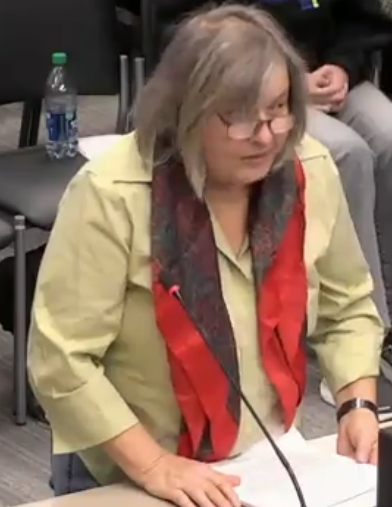 Irene Goodman reading her delegation to City Council They want to be heard; they want the members of Council to understand what their concern is.
More often than not, the people who delegate are talking about their homes, the streets they live on and the sense of neighbourhood that is so very important to them.
Most bring a sense of earnestness to their delegation. They want Council members to feel what they feel for their city.
They don’t understand why the members of Council don’t engage with them on what they worked so hard at saying to them.
It took the seven people who make up this City Council some time before they came up with the phrase: ‘You have made yourself perfectly clear, so much so that no one has any questions for you’, or words to that effect.
Those that have delegated for years bristle that that bit of lip service.
 Councillors Galbraith and Kearns appear to have had some urgent business to attend to while Irene Goodman was reading her delegation. On February 6th, when residents in the Shore Acres community wanted Council to listen to the concerns they had over an application to change the zoning on a piece of property that had a single detached dwelling to zoning that permitted semi-detached dwellings that would in this case permit two homes on a lot that had a single dwelling.
Do they listen?
These two didn’t listen when Irene Goodman was delegating.

 By Staff By Staff
February 17th, 2024
BURLINGTON, ON
 Halton Black Voices are inviting the public to their upcoming event at the Burlington Performing Arts Centre this coming Tuesday, February 20th, 5pm – 7pm. Halton Black Voices are inviting the public to their upcoming event at the Burlington Performing Arts Centre this coming Tuesday, February 20th, 5pm – 7pm.
The Burlington Performing Arts Centre has included Halton Black Voices to take part in their Pay it Forward Business Networking initiative that brings together the local business community to mingle and learn more about local charitable organizations
Registration is FREE! There will be appetizers, a cash bar and amazing door prizes! Hosted in the BPAC Lobby from 5pm to 7pm
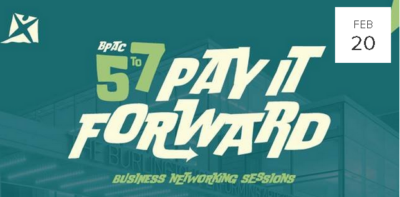 The BPAC 5 to 7 ‘Pay it Forward’ Business Networking Session The BPAC 5 to 7 ‘Pay it Forward’ Business Networking Session
Hosted By Mending the Chasm Inc.
in Support of Halton Black Voices
Tuesday, February 20th from 5pm to 7pm
Performing Arts – Family Lobby

 By Pepper Parr By Pepper Parr
February 16th, 2024
BURLINGTON, ON
OPINION
Some movement on that Special Council Meeting that the public was not able to see on the webcast.
There was no information on the city website about a Special meeting of Council – even though the Mayor had advised her colleagues not to leave after the adjournment of a meeting of Council.
We waited to watch the webcast once the room has been “reset”.
When we saw nothing we reached out to Councillor Paul Sharman who assured us there was nothing much of interest.
We then reached out to the City Clerk. The answer to the questions we asked is as follows:
The meeting after Council was a continuation of the closed session meeting that was entered into on January 12, 2024, with respect to the City Manager interviews and deliberations.
As per the motion, the notice provisions are waived for this meeting. A report out in open session is forthcoming.
First question is: How long did the meeting last?
Second question is: Why do they need two days to report out on a meeting ? That level of information is usually given when the come out of the CLOSED session.
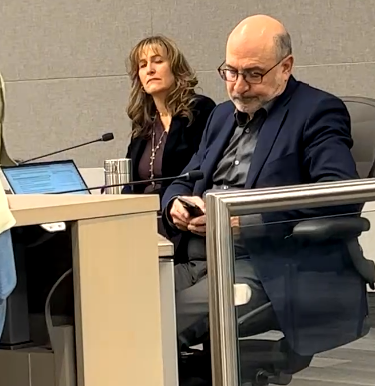 City Manager Tim Commisso working his cell phone – Mayor Med Ward looking on – wondering perhaps? We have suspected that the meeting was related to the position of city manager. Tim Commisso is scheduled to leave at the end of June. The interviewing process is currently taking place.
The City did send us the Minutes for the February 12th meeting. How you date the minutes February 12 for a meeting that took place on the 14th is beyond us.
Those minutes are set out in their entirety:
Special Meeting of Council Minutes
Members Present:
Mayor Marianne Meed Ward, Kelvin Galbraith, Lisa Kearns, Rory Nisan, Paul Sharman, Angelo Bentivegna
Member Regrets: Shawna Stolte
Staff Present:Tim Commisso, Samantha Yew (Deputy Clerk), Sue Evfremidis, Richard Bellemare (Audio/Video Specialist), Debbie Hordyk
Note: This City Council meeting was conducted using a hybrid model, allowing members of Council, city staff and delegations the option of participating remotely or in- person.
- Call to Order:
- Regrets:
- Land Acknowledgement:
The Chair read the land acknowledgement.
- Approval of the Agenda:
Moved by: Councillor Sharman Seconded by: Councillor Nisan
Approve the agenda as presented.
CARRIED
- Declarations of Interest:
None.
-
-
- Delegations:
- Jim Thompson spoke regarding City Manager Recruitment (HR-02-24)
- Items to be considered at the Special Meeting of Council:
- City Manager Recruitment (HR-02-24)
Set out in blue below is the information we had to chase the Communication
Moved by: Councillor Bentivegna Seconded by: Councillor Kearns
That Council proceed into Special Council Closed Session meetings in January and February 2024, to conduct confidential interviews and deliberations related to the recruitment of the City Manager position pursuant to Municipal Act, 2001 sections:
239(2)(b) personal matters about an identifiable individual, including municipal or local board employees, and
239(2)(k), a position, plan, procedure, criteria or instruction to be applied to any negotiations carried on or to be carried on by or on behalf of the municipality or local board; and
Direct the City Clerk to schedule Special Council Closed Session meetings as required to conduct confidential interviews and deliberations for City Manager position in the months of January and February pursuant to Municipal Act, 2001 sections:
239(2)(b) personal matters about an identifiable individual, including municipal or local board employees, and
239(2)(k), a position, plan, procedure, criteria or instruction to be applied to any negotiations carried on or to be carried on by or on behalf of the municipality or local board, and;
That this resolution satisfies the Closed Session meeting requirements set out in section 239(4)(a) of the Municipal Act, 2001 and Section 27.2 of the City’s Procedure By-law for any meetings scheduled for the purpose of City Manager interviews and deliberations; and
Waive the notice and agenda provisions of the Procedure By-law including sections 22.1, 24.5, 24.6 for all meetings called for the purpose of City Manager interviews and deliberations; and
Waive the Closed Session provisions of section 27.6 of the Procedure By- law to allow the result of these meetings be reported collectively out at future meeting of Council, where Chair will accept a motion regarding the matters discussed in the closed sessions, or alternatively advise that direction had been given to staff during the closed sessions in accordance with the Municipal Act.
IN FAVOUR: (6): Mayor Meed Ward, Councillor Galbraith, Councillor Kearns, Councillor Nisan, Councillor Sharman, and Councillor Bentivegna
CARRIED (6 to 0)
- Motion to Receive and File Information Items:
Moved by: Councillor Nisan Seconded by: Councillor Galbraith
Receive and file information items, having been considered by Council:
CARRIED
Delegation notes from Jim Thomson regarding City Manager Recruitment (HR-02-24)
- Motion to Confirm Proceedings of the Council Meeting:
Moved by: Councillor Sharman Seconded by: Councillor Galbraith
Enact and pass By-law Number 01-2024 being a by-law to confirm the proceedings of Special Council at its meeting held January 12, 2024 being read a first, second and third time.
IN FAVOUR: (6): Mayor Meed Ward, Councillor Galbraith, Councillor Kearns, Councillor Nisan, Councillor Sharman, and Councillor Bentivegna
CARRIED (6 to 0)
Motion to Adjourn:
Moved by: Councillor Nisan Seconded by: Councillor Kearns
Adjourn this Council now to meet again at the call of the Mayor. 9:15 a.m. (recess), 9:17 a.m. (reconvene), 9:18 a.m. (adjourned)
CARRIED
Samantha Yew
Deputy Clerk
Marianne Meed Ward
Mayor
Related news story:
Councillor Sharman assures the Gazette
Salt with Pepper is the musings, reflections and opinions of the publisher of the Burlington Gazette, an online newspaper that was formed in 2010 and is a member of the National Newsmedia Council.

 By Staff By Staff
February 16th, 2024
BURLINGTON, ON
The Toronto Star reports that more than a million Ontarians have yet to renew their licence plates and are facing fines up to $1,000 — even though doing so is now free.
 How did that happen? How did that happen?
In 2022, premier Doug Ford scrapped the $120 annual licence plate renewal fee. The Star reports that charges for people with expired plates have skyrocketed, from 5,341 tickets in 2022 to 15,631 in 2023, according to Ontario Provincial Police. What’s the state of your plate?
· Removing the renewal charge was a signature policy of Ford’s after he campaigned on keeping costs down — but the act would cost the provincial treasury more than $1 billion a year.
· There was some confusion after licence plate renewal stickers were scrapped alongside the annual renewal fee, leading some motorists to think they no longer have to renew at all. Others, forgetting to remove the 2022 renewal sticker from their plates, wound up getting ticketed outside the province by police thinking their plates were expired.
· Get it done: One’s licence plate expiry date is usually the birthday of the owner; motorists can check their licence plate status and renew it online. You can see here if your licence plate has expired and renew your plate online here.

 By Staff By Staff
February 16th, 2024
BURLINGTON, ON
Ontario NDP Leader Marit Stiles said the Official Opposition is heading into the upcoming legislative session ready to present practical, hopeful solutions:
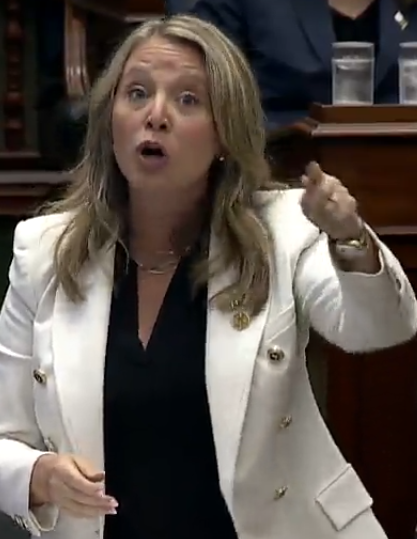 Ontario NDP Leader of the Opposition Marit Stiles whacking away at Premier Ford – every chance she gets. “People across our province are facing real challenges right now. People are waiting for hours for basic healthcare, they are stuck with sky-rocketing costs of housing, and their bills are not getting any lower. We need real solutions,” said Stiles. “But this government is too wrapped up in its never-ending scandals to come up with real solutions that matter to Ontarians.
The NDP is headed into this session focused on delivering solutions to housing, health care, and the rising cost of living.
“We’ve taken on a corrupt Conservative government and forced them to reverse course on countless bad decisions. Now, they’re under a criminal investigation for selling off the Greenbelt to the highest bidder and were forced to walk back wage-suppression policies after losing twice in court. Every climbdown and policy reversal is proof that when we work together, we can win.
“This session, we’ll keep holding Ford’s Conservatives to account, while putting forward the solutions that will make people’s lives easier.”
Stiles and the NDP will champion real solutions in the legislature, from targeting the staffing shortage in hospitals and underused public hospital resources, to expediting housing—including deeply affordable housing.
The Ford government slipped in a few goodies to draw attention away from the serious affordable housing problems with building starts far less than the province needs.

 By Pepper Parr By Pepper Parr
February 16th, 2024
BURLINGTON, ON
We now know why the Special Council meeting that took place on the 14th – was not webcast – the Gazette has been digging into that and we will report what we have learned later today. The way the city handled the Special Council meeting is the kind of thing that has to be taken to the Office of the Ombudsman.
The news that Hassaan Basit has been appointed the next City Manager was a bit of a surprise but also great news for the City.
What appears to have put Council into a real tizzy is that the current city manager Tim Commisso, wanted out – now. That got resolved at the Special Meeting.
The City Councillors had made up their mind on who they wanted in place and with that information in hand Tim Commisso felt he could leave the job.
He was a principled enough bureaucrat to stay on the job no matter how uncomfortable it may have been.
Mayor’s do not do what Meed Ward did to Tim – he didn’t deserve it and it wasn’t called for.
Hassaan Basit is a fine administrator. He did very good work at the Conservation Halton.
Gerry Smallegange, Chair of the Conservation Halton Board, put it perfectly when he expressed gratitude and extended congratulations to Hassaan:
“On behalf of the Conservation Halton Board, I want to congratulate Hassaan Basit on his new position with the City of Burlington. Hassaan has been an invaluable leader during his eight-year tenure as President and CEO of Conservation Halton, and nearly two decades of dedicated service with the organization. His departure is a significant loss — Hassaan is widely respected as an engaging and transformative leader, guiding Conservation Halton through challenging times, as evidenced during the complexities of the pandemic and an ever-changing regulatory landscape.
“His visionary approach has left an indelible mark. He redefined Conservation Halton’s business model, shaping two ground-breaking strategic plans that have not only elevated our business outcomes — providing financial stability and growth — but also fostered a positive organizational culture, instilling a growth and innovation mindset, collaborative problem-solving, and continuous learning.
Gerry got that right.
Related news stories:
The Mayor and the City Manager
The first look at Hassaan when he was appointed President & CAO at Conservation Halton

|
|
 By Staff
By Staff






















































 It started when she was awarded a grant from the Burlington Arts and Culture Fund to put on a concert, The Gratitude Project, just as things opened up after the pandemic. It was extremely well received by the public.
It started when she was awarded a grant from the Burlington Arts and Culture Fund to put on a concert, The Gratitude Project, just as things opened up after the pandemic. It was extremely well received by the public.




 Halton Black Voices are inviting the public to their upcoming event at the Burlington Performing Arts Centre this coming Tuesday, February 20th, 5pm – 7pm.
Halton Black Voices are inviting the public to their upcoming event at the Burlington Performing Arts Centre this coming Tuesday, February 20th, 5pm – 7pm. The BPAC 5 to 7 ‘Pay it Forward’ Business Networking Session
The BPAC 5 to 7 ‘Pay it Forward’ Business Networking Session
 How did that happen?
How did that happen?





